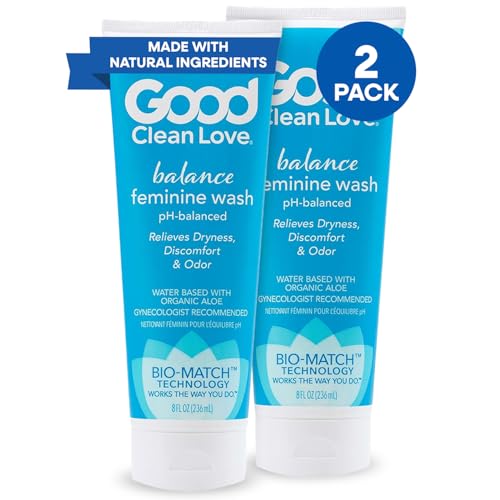
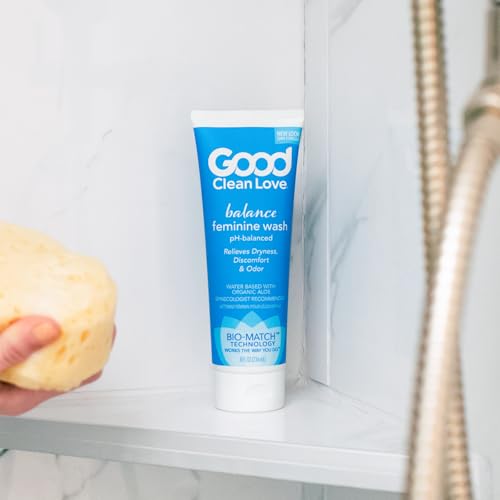

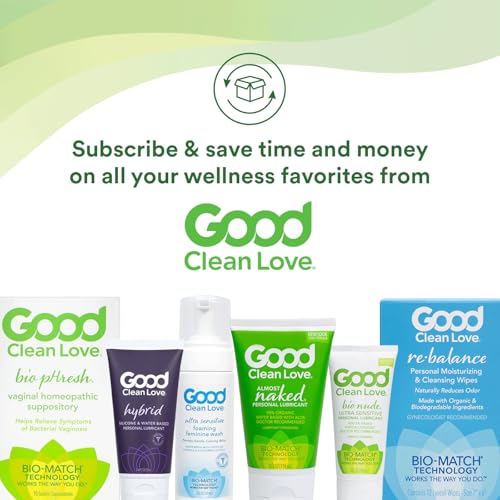
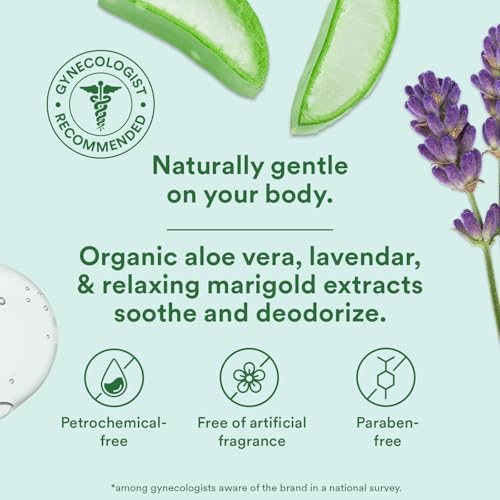
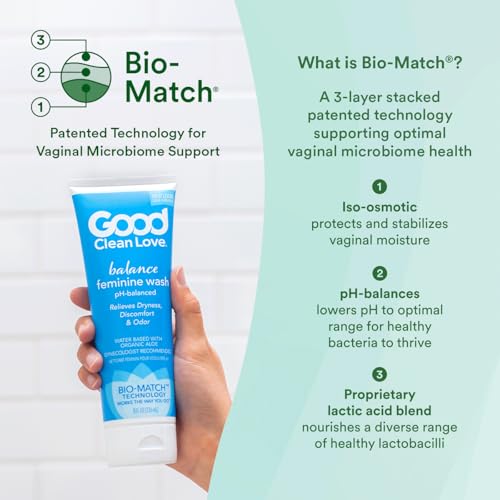

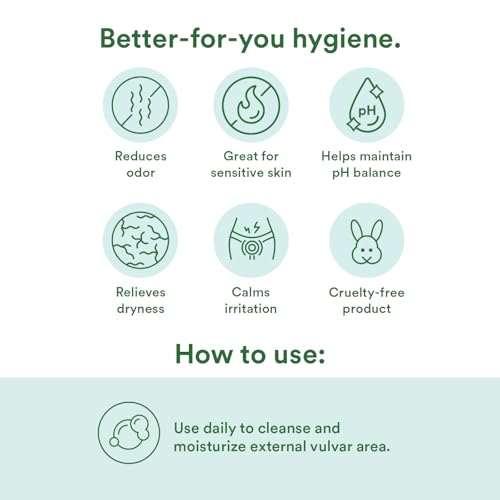
Good Clean Love Balance Feminine Wash - pH-Balanced Moisturizer, Soothing Botanicals - 8 Oz (2-Pack)


Lactic Acid, L
High RiskLactic acid is an organic acid commonly used in cosmetics and skincare products as an exfoliant and pH regulator. It helps in improving skin texture and hydration by promoting the shedding of dead skin cells and enhancing moisture retention.
Sustai Insights
Lactic acid offers functional benefits as an effective exfoliant and moisturizer, contributing to improved skin appearance. However, it poses potential risks, including skin irritation and enhanced absorption, which may lead to adverse effects. Regulatory bodies have noted use restrictions due to these concerns. Overall, the ingredient is considered high risk, necessitating cautious usage, particularly for sensitive skin. Alternatives like glycolic acid may provide similar benefits with potentially lower irritation.
Potassium Sorbate
Medium RiskPotassium sorbate is a potassium salt of sorbic acid, primarily used as a preservative in food and cosmetic products. It inhibits the growth of molds, yeast, and some bacteria, extending the shelf life of products. It is commonly found in various formulations due to its effectiveness and low toxicity.
Sustai Insights
Potassium sorbate serves as an effective preservative, preventing microbial growth in food and cosmetic products, which is vital for safety and longevity. Although it has a low risk of carcinogenicity and developmental toxicity, there is a moderate concern regarding allergies and immunotoxicity. Environmentally, it poses minimal risks as it is not significantly bioaccumulative. Regulatory agencies have verified its use, although some products may face restrictions. Overall, it is assessed as a medium risk ingredient, with safe usage practices recommended, and alternatives such as natural preservatives could be considered.
Sodium Benzoate
Medium RiskSodium benzoate is a preservative commonly used in food and cosmetic products to prevent microbial growth and extend shelf life. It is derived from benzoic acid and is effective at low concentrations, often used in acidic environments like beverages and condiments.
Sustai Insights
Sodium benzoate serves effectively as a preservative, contributing to product stability and safety. It is generally recognized as safe with low concerns for carcinogenicity, allergies, and reproductive toxicity, though it faces moderate use restrictions in some regions. Environmental risks include its potential as a pollutant, but it does not bioaccumulate significantly. Regulatory bodies have issued advisories regarding its concentration in products. Overall, the risk level is assessed as medium, with safe usage practices recommended. Alternatives such as potassium sorbate may provide similar benefits with potentially lower restrictions.
Sodium Lauryl Glucose Carboxylate
Low RiskSodium lauryl glucose carboxylate is a surfactant derived from natural sources, primarily used for its cleansing and foaming properties in personal care products. It functions effectively to remove dirt and oil from skin and hair while being gentle on the skin.
Sustai Insights
This ingredient offers functional benefits as a mild surfactant that promotes cleansing without significant irritation, making it suitable for sensitive skin. It is considered biodegradable and derived from renewable sources, aligning with sustainability principles. The health risks are low, with minimal concerns regarding irritation and no significant immunotoxicity or carcinogenicity. Environmental risks are also low, with no evidence of bioaccumulation. Regulatory status is clear, with no current restrictions. Overall, it is assessed as low risk, making it a favorable option in formulations.
Sodium Cocoamphoacetate
Low RiskSodium cocoamphoacetate is an amphoteric organic compound derived from coconut oil. It functions primarily as a surfactant and cleansing agent in personal care products, aiding in the formulation of mild and effective products suitable for skin and hair applications.
Sustai Insights
Sodium cocoamphoacetate offers functional benefits as a mild surfactant, enhancing foaming and cleansing properties without significant irritation. It is considered low-risk for health concerns such as carcinogenicity, allergies, and reproductive toxicity. Environmental risks are minimal, as it is not bioaccumulative and is biodegradable. However, there may be slight irritation potential for sensitive individuals. Regulatory status is generally permissive, with no major restrictions noted. Overall, the ingredient is assessed to have a low risk profile, making it a suitable choice in formulations.
Caprylyl/ Capryl Glycoside
Low RiskCaprylyl/Capryl Glycoside is a surfactant derived from natural sources, primarily used in personal care and cosmetic products for its emulsifying properties. It helps to stabilize formulations and enhance cleaning efficacy while being gentle on the skin.
Sustai Insights
Caprylyl/Capryl Glycoside offers functional benefits as a mild surfactant and emulsifier, contributing to product stability without significant irritation. It is biodegradable and considered sustainably sourced. Health risks are low, with minimal concerns regarding carcinogenicity and developmental toxicity. Environmental impact is also low, as it does not accumulate in ecosystems. Regulatory assessments indicate no current restrictions. Overall, it presents a low risk profile, making it a suitable choice in formulations.
Hydrastis Canadensis (Goldenseal) Extract
Low RiskHydrastis canadensis (goldenseal) extract is derived from the roots of the goldenseal plant, commonly used in herbal medicine. It is known for its potential antimicrobial and anti-inflammatory properties and is often included in topical formulations and dietary supplements.
Sustai Insights
Hydrastis canadensis extract offers functional benefits primarily through its antimicrobial properties, making it useful in various therapeutic applications. It is considered low risk for health concerns, with minimal evidence linking it to carcinogenicity, allergies, or reproductive toxicity. Environmentally, it poses low risks, with no significant pollutants or bioaccumulation noted. Regulatory bodies have not issued specific warnings, reinforcing its low-risk classification. Safe usage practices should be followed, especially in sensitive populations, and while alternatives exist, goldenseal extract remains a low-risk option overall.
Cocamidopropyl Hydroxysultaine
Low RiskCocamidopropyl hydroxysultaine is a synthetic skin and hair conditioning agent commonly used in personal care products. It functions primarily as a surfactant, providing foaming and emulsifying properties, while also contributing to the conditioning of hair and skin.
Sustai Insights
Cocamidopropyl hydroxysultaine offers functional benefits as a mild surfactant and conditioning agent, with low concerns regarding carcinogenicity, allergies, and reproductive toxicity. It is generally regarded as safe with low irritation potential. Environmental assessments indicate low pollutant potential and minimal bioaccumulation. Regulatory bodies have not imposed significant restrictions on its use, aligning with low risk levels overall. Safe usage is advised, particularly for sensitive populations, and alternative gentle surfactants may be considered for those seeking greener options. In conclusion, this ingredient is classified as low risk.
Glyceryl Oleate
Low RiskGlyceryl oleate is composed of glycerin and oleic acid, functioning primarily as an emulsifier and surfactant in cosmetic and personal care products. It helps to stabilize formulations by blending water and oils while also offering moisturizing properties.
Sustai Insights
Glyceryl oleate is effective in emulsifying and moisturizing, contributing positively to product texture. It is considered low risk for health concerns such as carcinogenicity, allergies, and developmental toxicity, although moderate irritation potential exists. Environmentally, it does not significantly contribute to pollution or bioaccumulation. Regulatory bodies have not issued restrictions, affirming its safety for use. Overall, it is regarded as a low-risk ingredient, with no immediate health or environmental hazards noted, making it a suitable choice in formulations.
Dimethyl Lauramide/Myristamide
Low RiskDimethyl lauramide/myristamide is a synthetic fatty acid amide derived from lauric and myristic acids, commonly utilized as a surfactant and emulsifier in personal care and cosmetic formulations. It contributes to product texture and stability, enhancing application properties without imparting significant fragrance or color.
Sustai Insights
Dimethyl lauramide/myristamide serves effectively as an emulsifier, improving product consistency and stability. It is not known to exhibit significant health risks, with low concerns for cancer, allergies, or toxicity, and is not currently restricted in use. Environmentally, it poses a low risk for pollution or bioaccumulation. Regulatory bodies have not issued warnings against this ingredient. Overall, it is assessed as low risk, making it a viable option in formulations. Alternatives include plant-based emulsifiers for those seeking sustainable options.
Vegetarian Glycerin
Low RiskVegetarian glycerin, also known as glycerol, is a colorless, odorless, and viscous liquid derived from plant sources. It is primarily used as a humectant, solvent, and emollient in various personal care products, helping to retain moisture and improve texture.
Sustai Insights
Vegetarian glycerin offers functional benefits as an effective humectant, promoting hydration and skin smoothness. It is biodegradable and typically sustainably sourced. Health risks associated with glycerin are low, with no significant concerns for carcinogenicity, allergens, or reproductive toxicity. Environmental risks are minimal, and it is not subject to major regulatory warnings. Overall, the risk level for this ingredient is low, making it a safe choice in formulations. Safe usage practices include ensuring proper concentrations in products, and alternatives such as propylene glycol exist but may have differing properties.
Mahonia Aquifolium Root Extract
Low RiskMahonia aquifolium root extract is derived from the roots of the Mahonia aquifolium plant, commonly known as Oregon grape. This extract is often utilized in cosmetic formulations for its potential skin-soothing properties and is recognized for its natural compounds, including berberine, which may contribute to its functional benefits.
Sustai Insights
Mahonia aquifolium root extract is valued for its skin-soothing and anti-inflammatory properties, making it beneficial in various cosmetic products. It is sustainably sourced and not associated with significant health risks, such as carcinogenicity or irritation. Regulatory assessments indicate low concern for allergies and reproductive toxicity. However, environmental risks seem minimal, and it is not classified as a pollutant. Overall, the ingredient is recognized as low risk, with no current usage restrictions, and remains a suitable choice in formulations.
Sodium Lauryl Glucose Carboxylate
Low RiskSodium lauryl glucose carboxylate is a surfactant derived from natural sources, primarily used for its cleansing and foaming properties in personal care products. It functions effectively to remove dirt and oil from skin and hair while being gentle on the skin.
Sustai Insights
This ingredient offers functional benefits as a mild surfactant that promotes cleansing without significant irritation, making it suitable for sensitive skin. It is considered biodegradable and derived from renewable sources, aligning with sustainability principles. The health risks are low, with minimal concerns regarding irritation and no significant immunotoxicity or carcinogenicity. Environmental risks are also low, with no evidence of bioaccumulation. Regulatory status is clear, with no current restrictions. Overall, it is assessed as low risk, making it a favorable option in formulations.
Lactic Acid, L
High RiskLactic acid is an organic acid commonly used in cosmetics and skincare products as an exfoliant and pH regulator. It helps in improving skin texture and hydration by promoting the shedding of dead skin cells and enhancing moisture retention.
Sustai Insights
Lactic acid offers functional benefits as an effective exfoliant and moisturizer, contributing to improved skin appearance. However, it poses potential risks, including skin irritation and enhanced absorption, which may lead to adverse effects. Regulatory bodies have noted use restrictions due to these concerns. Overall, the ingredient is considered high risk, necessitating cautious usage, particularly for sensitive skin. Alternatives like glycolic acid may provide similar benefits with potentially lower irritation.
Sodium Cocoamphoacetate
Low RiskSodium cocoamphoacetate is an amphoteric organic compound derived from coconut oil. It functions primarily as a surfactant and cleansing agent in personal care products, aiding in the formulation of mild and effective products suitable for skin and hair applications.
Sustai Insights
Sodium cocoamphoacetate offers functional benefits as a mild surfactant, enhancing foaming and cleansing properties without significant irritation. It is considered low-risk for health concerns such as carcinogenicity, allergies, and reproductive toxicity. Environmental risks are minimal, as it is not bioaccumulative and is biodegradable. However, there may be slight irritation potential for sensitive individuals. Regulatory status is generally permissive, with no major restrictions noted. Overall, the ingredient is assessed to have a low risk profile, making it a suitable choice in formulations.
Potassium Sorbate
Medium RiskPotassium sorbate is a potassium salt of sorbic acid, primarily used as a preservative in food and cosmetic products. It inhibits the growth of molds, yeast, and some bacteria, extending the shelf life of products. It is commonly found in various formulations due to its effectiveness and low toxicity.
Sustai Insights
Potassium sorbate serves as an effective preservative, preventing microbial growth in food and cosmetic products, which is vital for safety and longevity. Although it has a low risk of carcinogenicity and developmental toxicity, there is a moderate concern regarding allergies and immunotoxicity. Environmentally, it poses minimal risks as it is not significantly bioaccumulative. Regulatory agencies have verified its use, although some products may face restrictions. Overall, it is assessed as a medium risk ingredient, with safe usage practices recommended, and alternatives such as natural preservatives could be considered.
Caprylyl/ Capryl Glycoside
Low RiskCaprylyl/Capryl Glycoside is a surfactant derived from natural sources, primarily used in personal care and cosmetic products for its emulsifying properties. It helps to stabilize formulations and enhance cleaning efficacy while being gentle on the skin.
Sustai Insights
Caprylyl/Capryl Glycoside offers functional benefits as a mild surfactant and emulsifier, contributing to product stability without significant irritation. It is biodegradable and considered sustainably sourced. Health risks are low, with minimal concerns regarding carcinogenicity and developmental toxicity. Environmental impact is also low, as it does not accumulate in ecosystems. Regulatory assessments indicate no current restrictions. Overall, it presents a low risk profile, making it a suitable choice in formulations.
Sodium Benzoate
Medium RiskSodium benzoate is a preservative commonly used in food and cosmetic products to prevent microbial growth and extend shelf life. It is derived from benzoic acid and is effective at low concentrations, often used in acidic environments like beverages and condiments.
Sustai Insights
Sodium benzoate serves effectively as a preservative, contributing to product stability and safety. It is generally recognized as safe with low concerns for carcinogenicity, allergies, and reproductive toxicity, though it faces moderate use restrictions in some regions. Environmental risks include its potential as a pollutant, but it does not bioaccumulate significantly. Regulatory bodies have issued advisories regarding its concentration in products. Overall, the risk level is assessed as medium, with safe usage practices recommended. Alternatives such as potassium sorbate may provide similar benefits with potentially lower restrictions.
Hydrastis Canadensis (Goldenseal) Extract
Low RiskHydrastis canadensis (goldenseal) extract is derived from the roots of the goldenseal plant, commonly used in herbal medicine. It is known for its potential antimicrobial and anti-inflammatory properties and is often included in topical formulations and dietary supplements.
Sustai Insights
Hydrastis canadensis extract offers functional benefits primarily through its antimicrobial properties, making it useful in various therapeutic applications. It is considered low risk for health concerns, with minimal evidence linking it to carcinogenicity, allergies, or reproductive toxicity. Environmentally, it poses low risks, with no significant pollutants or bioaccumulation noted. Regulatory bodies have not issued specific warnings, reinforcing its low-risk classification. Safe usage practices should be followed, especially in sensitive populations, and while alternatives exist, goldenseal extract remains a low-risk option overall.
Cocamidopropyl Hydroxysultaine
Low RiskCocamidopropyl hydroxysultaine is a synthetic skin and hair conditioning agent commonly used in personal care products. It functions primarily as a surfactant, providing foaming and emulsifying properties, while also contributing to the conditioning of hair and skin.
Sustai Insights
Cocamidopropyl hydroxysultaine offers functional benefits as a mild surfactant and conditioning agent, with low concerns regarding carcinogenicity, allergies, and reproductive toxicity. It is generally regarded as safe with low irritation potential. Environmental assessments indicate low pollutant potential and minimal bioaccumulation. Regulatory bodies have not imposed significant restrictions on its use, aligning with low risk levels overall. Safe usage is advised, particularly for sensitive populations, and alternative gentle surfactants may be considered for those seeking greener options. In conclusion, this ingredient is classified as low risk.
Glyceryl Oleate
Low RiskGlyceryl oleate is composed of glycerin and oleic acid, functioning primarily as an emulsifier and surfactant in cosmetic and personal care products. It helps to stabilize formulations by blending water and oils while also offering moisturizing properties.
Sustai Insights
Glyceryl oleate is effective in emulsifying and moisturizing, contributing positively to product texture. It is considered low risk for health concerns such as carcinogenicity, allergies, and developmental toxicity, although moderate irritation potential exists. Environmentally, it does not significantly contribute to pollution or bioaccumulation. Regulatory bodies have not issued restrictions, affirming its safety for use. Overall, it is regarded as a low-risk ingredient, with no immediate health or environmental hazards noted, making it a suitable choice in formulations.
Dimethyl Lauramide/Myristamide
Low RiskDimethyl lauramide/myristamide is a synthetic fatty acid amide derived from lauric and myristic acids, commonly utilized as a surfactant and emulsifier in personal care and cosmetic formulations. It contributes to product texture and stability, enhancing application properties without imparting significant fragrance or color.
Sustai Insights
Dimethyl lauramide/myristamide serves effectively as an emulsifier, improving product consistency and stability. It is not known to exhibit significant health risks, with low concerns for cancer, allergies, or toxicity, and is not currently restricted in use. Environmentally, it poses a low risk for pollution or bioaccumulation. Regulatory bodies have not issued warnings against this ingredient. Overall, it is assessed as low risk, making it a viable option in formulations. Alternatives include plant-based emulsifiers for those seeking sustainable options.
Vegetarian Glycerin
Low RiskVegetarian glycerin, also known as glycerol, is a colorless, odorless, and viscous liquid derived from plant sources. It is primarily used as a humectant, solvent, and emollient in various personal care products, helping to retain moisture and improve texture.
Sustai Insights
Vegetarian glycerin offers functional benefits as an effective humectant, promoting hydration and skin smoothness. It is biodegradable and typically sustainably sourced. Health risks associated with glycerin are low, with no significant concerns for carcinogenicity, allergens, or reproductive toxicity. Environmental risks are minimal, and it is not subject to major regulatory warnings. Overall, the risk level for this ingredient is low, making it a safe choice in formulations. Safe usage practices include ensuring proper concentrations in products, and alternatives such as propylene glycol exist but may have differing properties.
Mahonia Aquifolium Root Extract
Low RiskMahonia aquifolium root extract is derived from the roots of the Mahonia aquifolium plant, commonly known as Oregon grape. This extract is often utilized in cosmetic formulations for its potential skin-soothing properties and is recognized for its natural compounds, including berberine, which may contribute to its functional benefits.
Sustai Insights
Mahonia aquifolium root extract is valued for its skin-soothing and anti-inflammatory properties, making it beneficial in various cosmetic products. It is sustainably sourced and not associated with significant health risks, such as carcinogenicity or irritation. Regulatory assessments indicate low concern for allergies and reproductive toxicity. However, environmental risks seem minimal, and it is not classified as a pollutant. Overall, the ingredient is recognized as low risk, with no current usage restrictions, and remains a suitable choice in formulations.
Experience the gentle touch of Good Clean Love Balance Feminine Wash, a pH-balanced vaginal moisturizer designed for daily use. This gynecologist-recommended formula cleanses, refreshes, and reduces odor while soothing sensitive areas with natural ingredients.
- Gentle Cleansing & Moisturizing: Formulated with soothing Aloe Vera and calming Lavender, this wash effectively moisturizes and refreshes without harsh chemicals.
- pH Balance Maintenance: This wash helps maintain a healthy vaginal biome by balancing moisture and pH levels for optimal comfort.
- All-Natural Ingredients: Free from parabens and artificial fragrances, this wash uses organic botanicals to ensure safety and effectiveness.
- Gynecologist Approved: Developed with patented Bio-Match technology, mimicking your body’s natural chemistry for a tailored experience.
- Daily Use: Ideal for everyday hygiene, this wash integrates seamlessly into your routine, promoting long-lasting freshness and comfort.
Choose Good Clean Love Balance Feminine Wash for a clean, healthy, and empowered lifestyle.
Subscribe & Save with Sustai
- Best Price Guarantee: Always enjoy the lowest prices on sustainable home essentials.
- No Surprises: We’ll notify you before shipping. No hidden fees, ever.
- You’re in Charge: Change, pause, or cancel your subscription anytime with ease.
- Eco-Friendly Deliveries: Our grouped shipments mean less packaging and lower emissions.
Join us on a sustainable journey. Special offers for a limited time! Prices and promotions may change.
Recommended Products
Experience the gentle touch of Good Clean Love Balance Feminine Wash, a pH-balanced vaginal moisturizer designed for daily use. This gynecologist-recommended formula cleanses, refreshes, and reduces odor while soothing sensitive areas with natural ingredients.
- Gentle Cleansing & Moisturizing: Formulated with soothing Aloe Vera and calming Lavender, this wash effectively moisturizes and refreshes without harsh chemicals.
- pH Balance Maintenance: This wash helps maintain a healthy vaginal biome by balancing moisture and pH levels for optimal comfort.
- All-Natural Ingredients: Free from parabens and artificial fragrances, this wash uses organic botanicals to ensure safety and effectiveness.
- Gynecologist Approved: Developed with patented Bio-Match technology, mimicking your body’s natural chemistry for a tailored experience.
- Daily Use: Ideal for everyday hygiene, this wash integrates seamlessly into your routine, promoting long-lasting freshness and comfort.
Choose Good Clean Love Balance Feminine Wash for a clean, healthy, and empowered lifestyle.

You can have at most 2 Sustainable Steals products in your cart
Customer Reviews
Customers’ View
Customers appreciate the effectiveness and gentle cleansing nature of Good Clean Love's Balance Moisturizing Wash. Many users highlight its ability to clean without irritation, with comments like "it cleans well" and "non-drying, gentle, works." The mild scent and natural ingredients, such as organic aloe and lavender, resonate well with those seeking a product free from harsh chemicals. While opinions on moisture levels vary, overall feedback indicates satisfaction with its pH-balancing properties, which many find beneficial for maintaining vaginal health. Additionally, the product's eco-friendly formulation aligns with consumers' values for sustainable personal care. Overall, customers find this wash a reliable choice for daily hygiene that is both effective and considerate of their health and the environment.
AI-generated from the text of customer reviewsThis product is rated 5.0 of 5.0 stars.
It has received 18 reviews.




